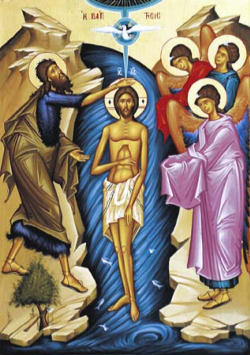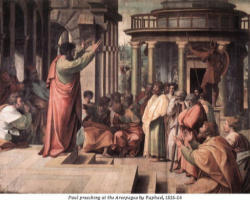 On April 2, 2005 at 9:37 p.m. the Venerable Pope John Paul II died. In April of 2009 his beloved successor, Pope Benedict XVI, told Pilgrims gathered in Rome “With you, I pray for the gift of beatification”. That prayer has been answered. Friday, January 14, 2011 the Holy See released the “Decree for the Beatification of the Servant of God John Paul II. The full decree is found here on the Vatican Radio site.
On April 2, 2005 at 9:37 p.m. the Venerable Pope John Paul II died. In April of 2009 his beloved successor, Pope Benedict XVI, told Pilgrims gathered in Rome “With you, I pray for the gift of beatification”. That prayer has been answered. Friday, January 14, 2011 the Holy See released the “Decree for the Beatification of the Servant of God John Paul II. The full decree is found here on the Vatican Radio site.
The choice of the Feast of Divine Mercy, May 1, 2011 is not accidental. He had a deep devotion to his fellow Pole Sr. Faustina Kowalska and to the Divine Mercy devotion identified with her. In August 2002, in Lagiewniki, Poland where Sr. Faustina lived and died, John Paul II entrusted the entire world “to Divine Mercy, to the unlimited trust in God the Merciful.”
The Decree of his Beatification notes, “Since the beginning of his pontificate, in 1978, John Paul II often spoke in his homilies of the mercy of God. This became the theme of his second encyclical, Dives in Misericordia, in 1980. He was aware that modern culture and its language do not have a place for mercy, treating it as something strange; they try to inscribe everything in the categories of justice and law. But this does not suffice, for it is not what the reality of God is about.”
With millions of the faithful I prayed throughout those final days of his life before he entered the eternal communion of love. What a gift he was – and still is. He showed us how to live and how to love as Jesus, poured out for others. He showed us that suffering joined to the Savior is a sign and vehicle of God’s mercy and an occasion of grace. Then, he showed us how to die, not with fear, but with faith.
This Polish Pope was so filled with the love of God it was contagious. A talented and gifted “man of letters”, a playwright, a philosopher, an intellectual giant, a poet, and a genuine human being , he had a heart that embraced the whole world like the Heart of the One whom he represented on earth.
He traversed the globe, proclaiming freedom to the captives and truth to the victims of failed false ideologies that had ravaged the people of the twentieth century, the bloodiest in all of human history. He proclaimed the unchanging, Christian message with a prophetic urgency, profound clarity and contemporary relevance.
Many tried to label him but he demonstrated how shallow the labels can be. He was simply a Christian who stood on the shoulders of giants, rooted in the ancient rich tradition of the Church while proclaiming Jesus Christ as “forever young.”
Communism, atheism, secularism, and false humanisms, were exposed because he had the courage to stand up to tyrants with the bold message of the God who came among us to make us all new! He taught that Jesus Christ is the path to authentic personal, social and universal freedom!
He authored more encyclical letters, apostolic exhortations, constitutions and letters than any Pope in the two thousand year history of the Christian Church. Once I started reading his writings as a young man I could not stop. I wanted to consume them, and I have done so, over and over.I also hoped to become them and offer them to others. On that front, I have a long way to go.
It was the writings of this great Pope which prompted a later call in life for this lawyer to the Diaconate and then to the pursuit of a Masters Degree at his Institute and later studies for the PhD in Moral Theology at Catholic University, focusing on his contributions. I knew I was to be a part of the “New Evangelization” and “New Springtime” of world missions which he proclaimed. His successor, Pope Benedict the Builder, is now leading the work.
Over many years I have come to understand more deeply the meaning of living in the communion of the Church because Pope John Paul II taught about it and lived it with such beauty. I have tried to practice his version of authentic ecumenism. I have tried to pass on to others his message of authentic freedom. However, the older I get, the more I realize how little I have accomplished.
This giant whose voice changed history was barely able to speak during those final hours. The once physically robust Pope presided over the Church from a wheelchair as a prophetic sign of the dignity of every human life; the message he carried throughout his pontificate. Just before he died he spoke to a friend at his bedside “I am happy. You should be too. Let us pray together with joy.” Then, on April 2, 2005 at 9:37 p.m. after asking, “Let me go to my Father’s House”, he died in peace. The world wept.
I remember his death like it was yesterday. Along with millions, my heart sunk as he was placed in the earth after such a long period of suffering. When the “transitus” (passing to eternal life) of this holy man was completed it seemed as though that earth stood still. History was changed by the witness of one man singularly conformed to the One whom he served, Jesus Christ.
Pope John Paul II became in both life and death a “living letter”, as St Paul wrote to the Corinthians. (2 Cor.3) Also, like the master he loved he became a “grain of wheat” fallen to the ground in order to bear much fruit. (John 12: 24-26) Like countless others my life was forever changed by this prophet who occupied Peters’ chair for such a brief time. I must admit, my heart still hurts when I think of him. I miss him.
Like millions, I am convinced that history will record him as “John Paul the Great.” However, I am also convinced that his message still needs to be unpacked in order to be used as material for the work to be done in this new missionary age.
There is no doubt that we had a saint in our midst. A man so filled with Jesus Christ that, like the Apostle Paul, he no longer lived but “Christ lived in him.” (Galatians 2) The sentiment of the faithful expressed on the day on which his body was processed through the streets of Rome, “Santo Subito” has echoed as the Church has discerned the cause of his canonization.
Now, he will be raised to the Altar on the Feast of Divine Mercy and the faithful will call him “Blessed John Paul II.” There is little doubt that soon, we will also affirm what the miracles effected by his continued intercession confirm, John Paul II is a Saint.

